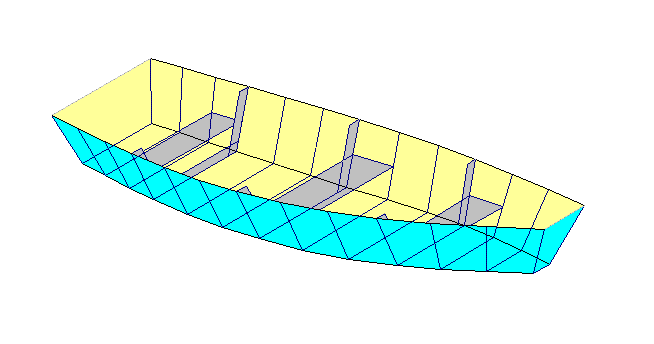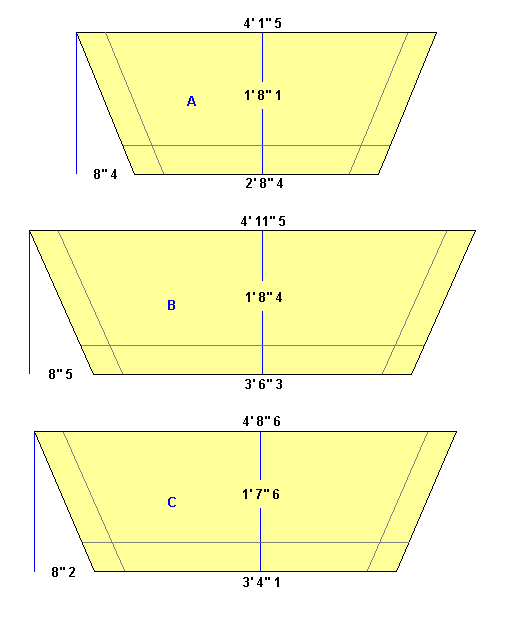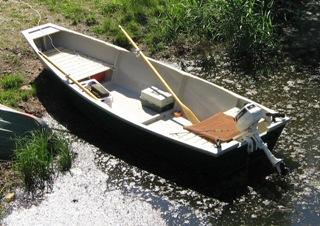
Here the resistance curves have been calculated for two passengers, unlike on most other plans.

Hi. I need a flat bottomed punt, some 13 to 17 feet, that could take a small outboard, 5 hp or so, and could be sculled and poled. The boat would be a fishing platform on shallow bays, for two to three people, and for occasional duck-hunting. The boat should be light, trailerable, should weigh less than 250 lbs.
Would You know of a plan for a boat like this, or could any of the boats on Your pages be scaled up to meet the specifications? Many commercial small boats are too narrow, or round bottomed, so that they are too unstable to stand up while fishing.
Would it make sense to add a keel, or rails, under the boat to protect the bottom and paint, and to improve directional stability when running with the engine?
I have a semi-finished plan for a boat just like You describe. The plans are down there. Take a look to see if they are "the kind of a box" that You are looking for.
Commercial boats unstable? Standing up while fishing? Do You have to stand up while fishing?
If You run a flat bottomed punt with an engine it makes sense adding some kind of a keel to the bottom, otherwise the boat will slide sideways when trying to turn. And it may flip, if the forward runnin chine "bites" water when sliding sideways. The keel can be made of some two by two. Also, if You need to pull the punt around along ground, You would probably like to add runners of some 1" by 1 1/2" close to the chines.
Ok, take a look of this. Is this what You dreamed of?
This is a 15'8" work/fishing punt, that can be sculled, but also driven with a small outboard. Up to some 4-5 hp. The front and rear seats are kept some distance from the ends, in order to be able to sit on the bench and angle directly ahead or astern without sitting corkscrewed.

The measeurements for the side panels. If You use a butt block joint (that is, use the whole lengths of both plywood sheets), use the upper measurements. If You use a scraph of 100 mm / 4" (that is, You lose 100 mm / 4" of the combined length of the sheets), use the measurements in brackets.


Bow and stern transoms.


The frames.


Placement of punt parts on four sheets of plywood. For a rough working boat
use 12 mm (1/2") for the bottom, 9 mm (3/8") for the sides. For a "finer"
version the bottom can be 9 mm (3/8"), sides 6.5 mm (1/4").
The transom is cut depending on the rig length of the outboard. In any case the
transom must be strengthened with quarter knees and transverse bracing.

Bodyplan, side and plan views.

The curve of volumes (the lengthwise distribution of the underwater volume of the hull) at about 660 lbs displacement (=total load). That is, the boat, two passengers and some gear. The curve seems to indicate easy travel at low speeds.

 |
Here the resistance curves have been calculated for two passengers, unlike on most other plans. |
Rt (violet curve) = total resistance
Rv (red curve) = viscous resistance (friction)
Rw (blue curve) = wave forming resistance
Rh (pale blue curve) = resistance created by transom stern
Full speed scale = 4.0 m/s = 14.4 km/h = 9.0 mph = 7.8 knots
Yes, this is just what I had in mind. It looks stable enough, and simple to build. One has to stand up when spinning with a lure. Only then You can fish effectively in every direction. Also, if You let the boat drift (which makes fishing very efficient) it will turn slowly this way and that way. The fisherman also has to turn then, in order to cast the lure to the correct spot. If You do this for hours, sitting down, You really know You have been fishing. Standing up is much lighter work.
I recall from some building instructions, that builders were told to avoid screws and other metal fasteners. Why is this? If one uses stainless screws, and covers them with epoxy, what harm can they do? How about wooden dowel pegs?
In my opinion one should avoid screws near corners in plywood stitch-and-glue construction. Corners will often be rounded, and if there are no screws hidden within plywood and epoxy rounding is much easier. Planes and sand paper work much better on wood than stainless steel ;-)
And screws don't really add to the strength of a glued joint.
Screws can, however, be used and left in place when assembling frames, or attaching a keel or a skeg to the bottom.
Equally, I don't recommend using copper wires in the plywood stitching phase, although many instructions do so. I always use plastic wire clips. They are easy to cut away with a sharp knife, and they don't do harm to Your plane iron nor to Your sand paper even if some are left in the plywood.
The measurements of the punt bottom are not given in the plans. I suppose the purpose is to assemble the frames, sides and transoms, and then draw the shape of the bottom onto the plywood using the assembled upper part of the boat as a template.
This is just the way to go.
Are the lower edges of the sides drawn with a help of a batten?
Yes. The points in the drawings are measured and marked on the plywood, small nails are driven into the points. A thin batten is then bent and pressed against the nails, and the line of the saw-cut is drawn along the batten edge.
Should I use plywood or thin boards for the frames?
I'd use thin boards. If You use plywood, it would need to be thicker than the plywood for the hull. And You have a lot of vulnerable plywood edge visible in plywood frames.
|
Building the punt prototype is proceeding well! Plywood sheets have been scraphed, frames assembled, and assembly of the hull started. |
Any ideas on how to do the bow and especially stern internal bracing in a neat and functional way? Quarter knees will be made of 3/4" plywood. The boat can soon be turned over and start finishing the inside. Until now it has been like a house of cards. Touch something, and everything changes.
At this point the hull is really like a house of cards. There is very little diagonal stiffness in an "open box" with thin sides.
First of all, gunwales need to be beefed up.
I see two possibilities. A stiffener only on the outside, in which case the gunwale
can be laminated out of two 3/4" x 2" (or so) battens. Or have a stiffener both on
the outside and inside. In which case the inside batten should be separated from
the plywood with intermittent pieces of batten.
A stiffener only on the outside is easier to build.
In the bow, I would put a cross brace on the inside of the bow transom. 1" x 3", the edge
against plywood.
On the inside, so that the brace can be used as a pulling handle.
On the stern transom I'd use some 1" thick boards for cross bracing, starting from the top, down to 2" to 4" below the outboard mounting screws. Then I'd cover these boards with a strip of plywood, so that the top of the transom would be a plywood-board-plywood sandwich.
Below the cross brace You could have a vertical board, 1" x 4", and a quarter knee connecting this vertical brace to the bottom/keel.
And quarter knees in the upper corners, of course.
Seats will make the punt a lot stiffer if they are attached to the sides. The wider the seats, the more diagonal stiffness they add.
Here You have a couple of drawings describing what I tried to say. The bow and stern, from top, from inside and from side.
In the stern:
In the bow:

I figured that the cross brace in the bow could be under the quarter knees. That way it can be attached really securely with screws through the quarter knees. The spot in the bow transom colored green can be sawn off, or filled up with a small piece of the quarter knee material.
The end of the outside gunwale battens are secured with long screws from the outside, through the hull sides, to the quarter knees.
Thanks for the drawings, this is now clear.
But some of the details I'm not going to follow :-)
|
First of all, I won't be using two quarter knees in the bow. Instead, a small foredeck, reaching from side to side. Very well, that is a simpler and stiffer solution. |
|
|
And a vertical quarter knee in the bow as well. Just like in the stern. Ok, ok. Getting stiffer and stiffer. |
And gunwales will have a batten on the outside and inside, but no intermittent blocks between the plywood and inside batten. I won't be tilting the boat to drain it, but will have a drain plug in the rear.
I have always wanted to keep the inside of the sides open, at least at some spot, to make it possible to drain the boat quickly and totally by tilting. This is really quite theoretical in a boat as large as this. The boat is too heavy and wide to tilt comfortably.
And I'm not going to have a mid seat in this boat. It is just in the way when fishing.
I have no opinion on that. I suppose You know best :-)
|
Back to the actual construction work. Sides are first glued and screwed to the frames. Transoms are stitched to the ends of sides with plastic wire clips. |
|
|
The shape of the bottom is drawn along the lower edge of the sides, bottom sawn, and stitched to the sides and transoms. Seams are glued, wire clips removed and seams reinforced with fiber glass tape on the outside. |
|
|
The boat is turned over. Seams are reinforced from the inside with fiber glass tape. |
|
|
The bow is braced. This punt is going to be equipped a large front seat. You can see the front seat support battens reaching from the bow transom to the frontmost frame. |
|
|
And similar bracing in the stern. Quarter knees between the sides and the transom, between the bottom and the transom, and cross bracing to carry the weight and push from an outboard motor. |
|
|
The rear seat is also going to occupy the whole space between the transom and the rearmost frame. |
|
 |
Gunwales completed. |
 |
Boat upside down again, the keel being attached. |
 |
The keel is laminated out of three strips. |
 |
Keel and side rails ready. |
 |
The positioning of side rails is, as most things in boatbuilding, a compromise.
Take the less bad of two bad choices ;-) |
 |
The boat completed, an aluminium rail screwed on to protect the keel. |
 |
The punt is ready, and has been used extensively. So far it has fulfilled almost all requirements and expectations. |
 |
It is really stable on water. Spinning with a lure works great. Space is luxurious for two. Pulling a lure behind the boat on a lake or a river is easy. A 4 hp outboard gives a top speed of just over 15 km/h ( = 9.4 mph = 8.1 knots = 4.2 m/s) riding alone, and slightly less with a passenger.
The reported top speed, by the way, is in good agreement with the resistance curves above. |
 |
I'm happy with the speed, but some hotheads who tried her said she needs a bigger engine. Would probably need a pilot's license, though. |
 |
The ride is comfortable, and one could speak of some sort of planing. No experience of big waves yet, but the hull feels rigid and there is no flexing of any sort in smaller waves. |
 |
The only drawback is the weight. The punt can be handled onto and off a trailer single-handed, but with difficulty. With two pairs of hands moving the punt around is relatively easy, however. I have no-one else but myself to blame for the extra weight. It was myself who wanted to beef the hull up extensively. |
The weight and stiffness come into good use on waters, however. Another failure is the choice of keel rail material. The aluminium rail was cheap and easy to drill, but oh shit how lousily it slides on sand, stone and trailer bottom. It sticks like glued onto everything. A plastic or stainless steel rail would have been much better.
 |
I added small fins to the outboard. They improved the ride by lifting the stern up at higher speeds. The speed increase was only 1-2 km/h, but with the fins the bow stays down making the ride more comfortable. With a passenger or other load in the bow the effect of the fins was negligible. |
I can recommend the punt to fishermen and duck hunters moving on protected waters. There is ample room for fishing tackle and all those things You need in a boat.